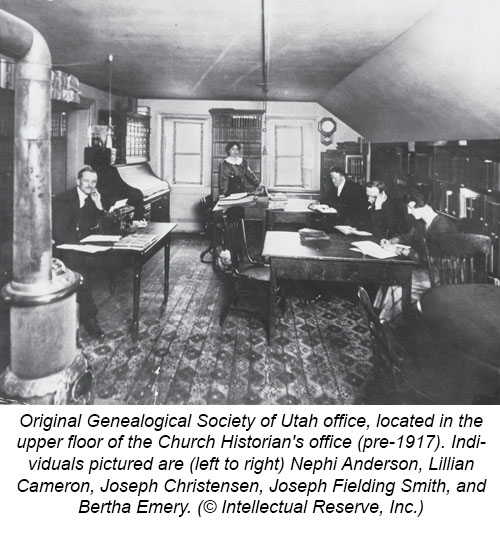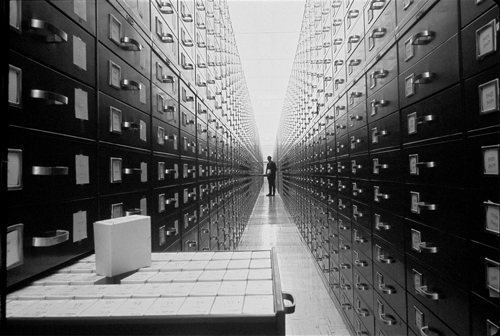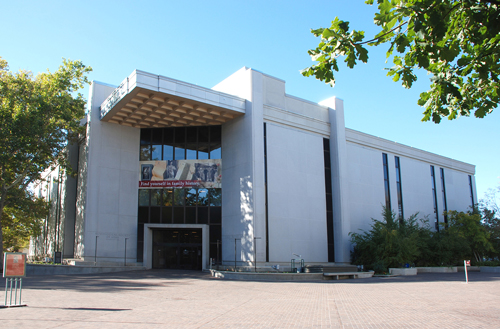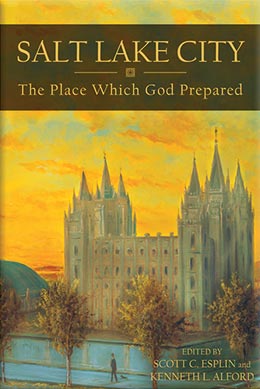Kip Sperry, “Salt Lake City: An International Center for Family History,” in Salt Lake City: The Place Which God Prepared, ed. Scott C. Esplin and Kenneth L. Alford (Provo, UT: Religious Studies Center, Brigham Young University; Salt Lake City: Deseret Book, Salt Lake City, 2011), 323–338.
Kip Sperry is a professor of Church history and doctrine at Brigham Young University.
What Latter-day Saints now understand as “the mission of Elijah” was first suggested to the Prophet Joseph Smith when the angel Moroni appeared to him on September 21, 1823, at his parents’ home in Palmyra (near Manchester), New York. Among other things, Moroni quoted, in modified form, the words of the Prophet Malachi: “Behold, I will reveal unto you the Priesthood, by the hand of Elijah the prophet, before the coming of the great and dreadful day of the Lord. And he shall plant in the hearts of the children the promises made to the fathers, and the hearts of the children shall turn to their fathers. If it were not so, the whole earth would be utterly wasted at his coming” (D&C 2:1–3; compare Malachi 4:5–6).
Twelve and a half years later on April 3, 1836, Elijah appeared to Joseph Smith and Oliver Cowdery in the Kirtland Temple, thus fulfilling Malachi’s prophecy and promise that Elijah would return with priesthood keys (see D&C 110:13–16). [1]
An epistle from Joseph Smith to the Latter-day Saints, recorded in Nauvoo, Illinois, on September 1, 1842 gave directions and emphasized the importance of keeping proper temple records: “And again, let all the records be had in order, that they may be put in the archives of my holy temple, to be held in remembrance from generation to generation, saith the Lord of Hosts” (D&C 127:9). A second epistle included this important charge: “Let us, therefore, as a church and a people, and as Latter-day Saints, offer unto the Lord an offering in righteousness; and let us present in his holy temple, when it is finished, a book containing the records of our dead, which shall be worthy of all acceptation” (D&C 128:24). These two passages of scripture are significant for a better understanding regarding Latter-day Saint interest and emphasis on record keeping and family history research.
While these revelations provided some guidance, additional clarification regarding work for the dead was necessary. Wilford Woodruff, fourth President of The Church of Jesus Christ of Latter-day Saints, received a revelation in April 1894 that Church members should be sealed to their fathers and mothers—that is, their ancestors. His announcement in general conference in Salt Lake City ended the “law of adoption,” a practice whereby some Church members were sealed by proxy in Latter-day Saint temples to prominent Church leaders instead of to their direct-line ancestors. [2] In making this important announcement, President Woodruff reemphasized the need for genealogical research and historical record keeping among the Latter-day Saints. Latter-day Saints who “seek out their ancestry have the spirit of Elijah as they turn their hearts to their ancestors and seal children to their parents. Thus, Elijah’s mission is fulfilled through the temple ordinances and priesthood authority to do this work.” [3]
Genealogical Society of Utah
Following this announcement in general conference, and with his emphasis on sealing families in Latter-day Saint temples, President Woodruff oversaw the organization of the Genealogical Society of Utah on November 13, 1894, emphasizing the value of genealogical research and historical record keeping. [4] The society’s stated purpose was to gather genealogical records and assist members of the Church with their family history and genealogical research. [5] Many nonmembers have also used the Church’s family history facilities for tracing their own family trees.
The purposes and functions of the Genealogical Society of Utah have changed over the years. The official organizational meeting was held in the Church Historian’s Office in Salt Lake City on November 13, 1894. “The Articles of Association of the Genealogical Society of Utah announced three types of purposes for the organization: benevolent, educational, and religious. The benevolent goal was to be met by establishing and maintaining a genealogical library for the benefit of Society members and others; the educational purpose was to disseminate information regarding genealogical matters; and the religious goal was to acquire records of the dead in order to enable the performance of Church ordinances on their behalf.” [6] To assist in this effort, the Genealogical Society of Utah published a quarterly for many years, the Utah Genealogical and Historical Magazine, which included doctrinal and religious articles, biographies, compiled genealogies, extracts of records, research methodology, and other news regarding genealogical research of particular interest to Latter-day Saints. [7]
The Church has made a major commitment to collecting genealogical and historical records and making them available to the public. The Genealogical Society of Utah is now known as FamilySearch, a nonprofit international organization sponsored by the Church. [8] Goals of FamilySearch are to gather, preserve, and share genealogical information throughout the world. FamilySearch is known worldwide for its microfilming, digitizing, and records preservation programs. Some of the services offered to archivists and other record custodians include image capturing, digital conversion, records preservation, online personal name indexing, and access to online family history and historical resources.
Family History Library
Soon after the organization of the Genealogical Society of Utah in 1894, the Church organized a research library to assist Church members and others in identifying their ancestors. The Genealogical Society Library, along with its book and periodical collection, initially shared space in the Church Historian’s Office at 58 East South Temple Street in Salt Lake City. The Genealogical Society was housed on the upper floor with a reading room, classroom, and temple recording areas. The fifth floor was primarily designed to store records and files of both the Church historian and the society.

With the 1917 completion of the Church Administration Building at 47 East South Temple Street, the society relocated to occupy the fourth floor of the new building, separating its activities from the Church Historian’s Office. The society remained in the Administration Building for nearly two decades until it was moved to the Joseph F. Smith Memorial Building at 80 North Main Street in 1934. This edifice had been part of the LDS College located near the former Hotel Utah.
The library’s transient history continued when its large collection of books, periodicals, microfilms, family group records, and index cards (including the Temple Records Index Bureau) were again relocated in 1962 into the abandoned Montgomery Ward building at 107 South Main Street. Some administrative offices were also housed in the Beehive Bank Building on State Street. With the 1972 completion of the Church Office Building at 50 East North Temple, the Genealogical Society Library, later known as the Genealogical Department Library, moved again, occupying all four floors of the building’s west wing, with administrative offices on several floors of the structure’s center tower. [9]
Finally, after over ninety years of serving family history patrons, the Genealogical Department found a home of its own when its present building was dedicated on October 23, 1985. [10] Located west of Temple Square at 35 North West Temple Street, the magnificent facility contains research space divided among five floors. It was renamed the Family History Library in 1987, but it is now known as the FamilySearch Family History Library (hereafter referred to as Family History Library). [11]
The Family History Library in downtown Salt Lake City is regarded as the largest, and frequently as the best, genealogical research library in the world, primarily because of its extensive microfilm collection. [12]
The Family History Library is part of the Family History Department, also known as FamilySearch. A summary of name changes of the Genealogical Society are [13]
- 1894–1944, Genealogical Society of Utah
- 1944–75, Genealogical Society
- 1975–87, Genealogical Department
- 1987–2000, Family History Department [14]
- 2000–2008, Family and Church History Department [15]
- 2008 to present, Family History Department [16]
The five-story Family History Library houses its collection in 142,000 square feet. Humidity, temperature, and lighting are controlled to protect the collection from deterioration. There, professional consultants, library attendants, and volunteers serve approximately 1,500 patrons each day. [17] Library orientation and specialized classes are offered regularly, and research consultation is available from experienced staff members and volunteers.
Although the initial library collection included mostly books and periodicals, the growth of materials greatly expanded when the Genealogical Society of Utah began microfilming and preserving genealogical and historical records in 1938. Original records were first microfilmed in Utah (1938), Tennessee (1939), New York (1940), North Carolina (1941), Hawaii (1942), California (1945), Pennsylvania and Georgia (1946), and Connecticut, Delaware, Maryland, New Jersey, Ohio, Virginia, and other states beginning in 1947, while other family history records on microfilm were purchased. [18] By 1954, the collection exceeded one hundred thousand microfilm reels. [19]
In 1965, Elder Theodore M. Burton (1907–89), then vice president of the Genealogical Society, inquired about whether the First Presidency thought Genealogical Society microfilming should continue. Their response was that “the Society should continue as it has been doing, and concentrate its efforts in the records of the United States, British Isles, and northern European countries and then spread into those areas in which there is the greatest number of new converts and where it can be done most economically and the data obtained most readily.” [20] Microfilming projects expanded internationally, first to Canada and then to European countries including Belgium, France, the Netherlands, Scandinavia, and West Germany; at the same time microfilming also expanded in the British Isles, Latin America, and the United States. [21] Since 1998, FamilySearch has been digitizing, rather than microfilming, genealogical and historical records in the United States and internationally.
As the world’s premier genealogical research library, the Family History Library includes millions of rolls of microfilm, microfiche, 350,000 books, 4,500 periodicals, maps and atlases, reference sources, and 3,700 electronic resources. It is estimated that the names of over 3 billion deceased people are included in this extensive collection. The online Library Catalog describes the library’s collections. [22] Library resources may be searched at no charge and the library is open to the public. The collection represents records from over 105 countries, territories, and possessions. Genealogical and historical records are primarily from the United States, Canada, British Isles and other European countries, Latin America, Asia, and Africa. A majority of the records contain information about individuals who lived from the sixteenth century to 1950, although some records are earlier while others are from a later time period. Records are preserved in their original language and the collection contains an estimated 12 billion individual names.
The FamilySearch Center in the Joseph Smith Memorial Building, located east of Temple Square in downtown Salt Lake City, is an extension of the Family History Library and has access to genealogical databases and family history resources. [23] Access to individual computer stations is provided, and staff and volunteers are available to assist patrons with FamilySearch, especially those beginning their family history research, free of charge. Family history centers, now known as FamilySearch Centers, are satellite facilities of the main Family History Library. Initiated in 1963, FamilySearch Centers are located throughout the United States and in over 127 other countries. The largest regional center in the Salt Lake Valley is the FamilySearch Library in Riverton, Utah. [24] Other FamilySearch Centers are located in affiliate libraries, such as public libraries.
In addition to the Family History Library, other major research facilities located in Salt Lake City house family and local history materials. These include the Church History Library, International Society Daughters of Utah Pioneers Library, National Society of the Sons of Utah Pioneers Library, Utah State Archives and Records Service, Utah State Historical Society Library, and the University of Utah J. Willard Marriott Library.
FamilySearch
The Church introduced a free family history website known as FamilySearch.org on May 24, 1999. [25] FamilySearch is a nonprofit organization sponsored by the Church and today has over 1 billion searchable names in its online databases. With over 15 billion hits since its launch in 1999, it is one of the most popular family history sites on the Internet. [26] The site receives over 10 million hits per day. Popular websites associated with FamilySearch.org include FamilySearch, FamilySearch Blog, FamilySearch Centers (family history centers), FamilySearch Forums, FamilySearch Indexing (also known as Worldwide Indexing), FamilySearch Labs, FamilySearch Research Wiki, Family History Archives, Family History Library, Family Trees, Historical Records, Library Catalog (Family History Library), FamilySearch Community Trees, and online research courses and learning resources. [27]
Granite Mountain Records Vault
In addition to sponsoring public records, the Church also stores the world’s largest collection of microfilmed and digitized genealogical and historical records in the Granite Mountain Records Vault. Construction of the vaults, which were tunneled into a mountainside, began in 1960. The vaults were completed in 1965 and dedicated in 1966. This long-term records storage facility lies beneath seven hundred feet of solid granite and consists of a series of tunnels containing over sixty-five thousand square feet. Constructed to safeguard master copies of microfilmed records, the vaults are located in Little Cottonwood Canyon, about twenty-five miles southeast of Salt Lake City. The vaults contain negative copies of original 16 mm and 35 mm microfilms, microfiche, digital masters of digitized records, and other valuable records, which are stored in a climate-controlled fifty-five-degree environment that maintains constant humidity and temperature. [28] Behind a fourteen-ton main door, the vaults are designed to protect the collection from natural disasters and calamities. Two videos that describe the construction and holdings of the Granite Mountain Records Vault were introduced at the National Genealogical Society’s annual conference held in Salt Lake City on April 28 through May 1, 2010. [29]
 Interior of one of the vaults in the Granite Mountain Records Vault. (© Intellectual Reserve, Inc.)
Interior of one of the vaults in the Granite Mountain Records Vault. (© Intellectual Reserve, Inc.)
The Granite Mountain Records Vault houses over 2.4 million rolls of microfilm masters and 1 million microfiche from more than 110 countries, territories, and possessions. The vaults contain over 3.3 billion significant genealogical and historical record images, such as cemetery records, census returns, church records, court records, emigration and immigration lists, family histories (compiled genealogies), land and property records, local histories, military records, naturalization records, vital records (births, marriages, and deaths), wills, probate records, and many others—in all containing over 20 billion names. [30] It is estimated that the microfilm masters could survive more than two hundred years because of the vault’s ideal preservation environment.
The goals of FamilySearch and the Genealogical Society of Utah are to digitize, preserve, and share its genealogical records. Approximately two hundred cameras are currently capturing genealogical and historical records in over forty-five countries. To preserve these records, four key processes are associated with the Granite Mountain Records Vault: (1) microfilm and digital masters are preserved and safeguarded; (2) duplicate copies of microfilm are created and made available to over 4,600 FamilySearch Centers in over 127 countries worldwide; (3) microfilmed records are converted to digital images in archives, courthouses, historical societies, libraries, and other record repositories throughout the world; and (4) quality digital image masters are preserved where images are captured using digital scanning technologies. “FamilySearch and the record custodians benefit from the record preservation and access services accompanying these camera operations, making more records available to more people faster.” [31]
Conclusion
Since 1894, the Genealogical Society of Utah, the Family History Department, and FamilySearch have grown into the largest genealogical organization in the world. They have provided over one hundred years of service preserving genealogical and historical records and lineage-linked genealogies throughout the world and for various time periods. Supported by a major research library in Salt Lake City, they have made their services and resources available to millions of people at no charge—including online personal name indexes created by over 125,000 volunteers, publications and finding aids, online research courses, and worldwide FamilySearch Centers. [32] Records are preserved for long-term storage in the Granite Mountain Records Vault, and are also made available online at no charge to a global community. For many years FamilySearch has assisted churches, commercial companies, genealogical organizations, governments, libraries, record custodians, societies, and software developers in helping thousands of people search for their ancestors, thus fulfilling Malachi’s ancient prophecy that the prophet Elijah would “turn the heart of the fathers to the children, and the heart of the children to their fathers” (Malachi 4:6).
Computer and digital technology and personal name indexes have revolutionized genealogical record keeping and access. Today more people are interested in tracing their ancestry than ever before. Advancements in computer technology and the Internet continue to make family history research easier, available to more people, and more rewarding. [33] FamilySearch is helping people achieve their family history goals. Salt Lake City is truly the world’s international center for family history.
 Church History Library in Salt Lake City. (Courtesy of Woody Johnson.)
Church History Library in Salt Lake City. (Courtesy of Woody Johnson.)
Notes
[1] See Karl Ricks Anderson, Joseph Smith’s Kirtland: Eyewitness Accounts (Salt Lake City: Deseret Book, 1989), and Milton V. Backman Jr., The Heavens Resound: A History of the Latter-day Saints in Ohio, 1830–1838 (Salt Lake City: Deseret Book, 1983).
[2] Deseret News 2011 Church Almanac (Salt Lake City: Deseret News, 2011), 287. For additional information regarding the law of adoption, see Gordon Irving, “The Law of Adoption: One Phase of the Development of the Mormon Concept of Salvation, 1830–1900,” BYU Studies 14, no. 3 (1974): 291–314.
[3] Kip Sperry, “From Kirtland to Computers: The Growth of Family History Record Keeping,” in The Heavens Are Open: The 1992 Sperry Symposium on the Doctrine and Covenants and Church History (Salt Lake City: Deseret Book, 1993), 291.
[4] James B. Allen, Jessie L. Embry, and Kahlile B. Mehr, Hearts Turned to the Fathers: A History of the Genealogical Society of Utah, 1894–1994 (Provo, UT: BYU Studies, Brigham Young University, 1995), 44–47; see also 2011 Church Almanac, 84, 287.
[5] The Genealogical Society of Utah is an incorporated, nonprofit educational institution funded by the Church.
[6] Allen, Embry, and Mehr, Hearts Turned to the Fathers, 45–46.
[7] The Utah Genealogical and Historical Magazine was first published in 1910 and discontinued in 1940.
[8] Consult the Genealogical Society of Utah website for more details (www.gensocietyofutah.org). The Genealogical Society of Utah does business as FamilySearch International, especially when dealing with international record custodians, and is the genealogical arm of The Church of Jesus Christ of Latter-day Saints. FamilySearch International is usually shortened to FamilySearch. The name of the Genealogical Society of Utah was changed in 1944; however, the incorporated name of the society is still used today and appears on the entrance to the Family History Library in Salt Lake City. FamilySearch is the consumer brand name for the Family History Department for a variety of products and services, including the FamilySearch.org website, Family History Library, and the FamilySearch Centers. FamilySearch is an umbrella term representing all of the Genealogical Society’s facilities and services. FamilySearch International is used in legal documents and contracts.
[9] Allen, Embry, and Mehr, Hearts Turned to the Fathers, 45–49, 84–86, 123–24, 195–98, 295–98.
[10] Elder Richard G. Scott, then executive director of the Genealogical Department, conducted the dedicatory service and delivered the opening address. See “Memorandum,” Family History Department, November 1985.
[11] Family History Library, 35 North West Temple Street, Salt Lake City, UT 84150-3440. Telephone (801) 240-2584, (800) 346-6044, or (866) 406-1830 (www.familysearch.org). Research assistance is available in person, by mail, telephone, e-mail (fhl@familysearch.org), or fax (801) 240-5551. The library is located directly west of Temple Square.
[12] Consult the library’s website for more details (www.familysearch.org).
[13] Historical background courtesy of Christine Cox, director, and Sherry Smith, Church History Customer Services, Church History Library, The Church of Jesus Christ of Latter-day Saints, Salt Lake City; and Paul Nauta, FamilySearch Public Affairs Manager, FamilySearch, Salt Lake City; see also Allen, Embry, and Mehr, Hearts Turned to the Fathers; George D. Durrant, “Genealogical Society of Utah,” in Encyclopedia of Mormonism, ed. Daniel H. Ludlow (New York: Macmillan, 1992), 2:537–38; and “Welcome to the Family History Library” (Salt Lake City: Intellectual Reserve, 2005). Kahlile B. Mehr and D. Merrill White of FamilySearch provided additional details.
[14] In 1987, Church leaders announced the Genealogical Library would be renamed Family History Library.
[15] On June 1, 2000, the Family History Department and the Historical Department of the Church merged into the Family and Church History Department, which included the Family History Library.
[16] On April 7, 2008, the Family and Church History Department separated functions and became the Family History Department and the Church History Department.
[17] Raymond S. Wright, “Family History Library,” in Encyclopedia of Mormonism, 2:495.
[18] Microfilm operator reports by James M. Black (1914–93), former North American microfilming supervisor. See also James M. Black, “Microfilming Experiences of James M. Black, 1938–1972, in Service with the Genealogical Society,” typescript, January 1972 (Family History Library microfilm 1313899).
[19] David Ouimette, “Digitizing the Records in the Granite Mountain,” FamilySearch Research Wiki (https://
[20] Genealogical Society Minutes, January 21, 1965, quoted in Allen, Embry, and Mehr, Hearts Turned to the Fathers, 233–34.
[21] Kahlile B. Mehr, “Acquisitions, 1950–1970” (unpublished paper, manuscript).
[22] See the FamilySearch Library Catalog online (http://
[23] FamilySearch Center, Joseph Smith Memorial Building, 15 East South Temple Street, Salt Lake City, UT 84150-3460. Telephone (801) 240-4085 (familysearch@ldschurch.org).
[24] See Riverton FamilySearch Library, FamilySearch Research Wiki (https://
[25] The library’s catalog and automated databases were made available on the Internet in 1999, originally known as FamilySearch Internet Genealogy Service. See FamilySearch Facts and Statistics (http://
[26] There are four versions of FamilySearch: (1) the original version, available in DOS format in FamilySearch Centers, which still has several useful genealogical databases, (2) the first Internet version, sometimes known as the “classic” version of FamilySearch, (3) New FamilySearch containing compiled lineages, and (4) FamilySearch.org (www.familysearch.org).
[27] Eventually these separate FamilySearch links, databases, and indexes will be included as part of FamilySearch.org. FamilySearch will also maintain FamilySearch Labs (https://
[28] The first digital images from documents in local archives arrived in the Granite Mountain Records Vault in 1998.
[29] Granite Mountain Records Vault videos are available online (http://
[30] Thousands of original images of indexed and unindexed digitized records (such as census returns, vital records, and many others), are available online as Historical Records in FamilySearch.org. Thousands of these digitized images have been indexed by volunteers using the Church program known as FamilySearch Indexing. Indexing is the transcription of the key fields in a record, such as personal names, dates of events, birthplace, other place names, and so forth.
[31] Ouimette, “Digitizing the Records in the Granite Mountain.”
[32] Branch libraries were formerly known as family history centers, now FamilySearch Centers.
[33] It is necessary to note that not all original records and printed sources are digitized, indexed, and available on the Internet. It is also necessary to stress the importance of using original records and primary sources whenever possible when performing genealogical and historical research and always citing the source where the information was found. An encyclopedic and comprehensive guidebook is Elizabeth Shown Mills, Evidence Explained: Citing History Sources from Artifacts to Cyberspace, 2nd ed. (Baltimore: Genealogical Publishing, 2009), which serves as an illustrated guide to the fundamentals of evidence analysis and source citation. See also Elizabeth Shown Mills, Evidence! Citation & Analysis for the Family Historian (Baltimore: Genealogical Publishing, 1997).
